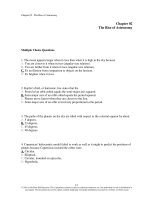Larry l hench an introduction to bioceramics 2nd edition imperial college press (2013)
Bạn đang xem bản rút gọn của tài liệu. Xem và tải ngay bản đầy đủ của tài liệu tại đây (14.33 MB, 597 trang )
AN INTRODUCTION TO
BIOCERAMICS
Second Edition
www.pdfgrip.com
P884_9781908977151_tp.indd 1
11/3/13 3:18 PM
b1486 An Introduction to Bioceramics 2nd Edition
This page intentionally left blank
www.pdfgrip.com
b1486_FM.indd ii
3/11/2013 3:10:13 PM
AN INTRODUCTION TO
BIOCERAMICS
Second Edition
Editor
Larry L. Hench
University of Florida, USA
ICP
P884_9781908977151_tp.indd 2
Imperial College Press
www.pdfgrip.com
11/3/13 3:18 PM
Published by
Imperial College Press
57 Shelton Street
Covent Garden
London WC2H 9HE
Distributed by
World Scientific Publishing Co. Pte. Ltd.
5 Toh Tuck Link, Singapore 596224
USA office: 27 Warren Street, Suite 401-402, Hackensack, NJ 07601
UK office: 57 Shelton Street, Covent Garden, London WC2H 9HE
British Library Cataloguing-in-Publication Data
A catalogue record for this book is available from the British Library.
AN INTRODUCTION TO BIOCERAMICS
Second Edition
Copyright © 2013 by Imperial College Press
All rights reserved. This book, or parts thereof, may not be reproduced in any form or by any means,
electronic or mechanical, including photocopying, recording or any information storage and retrieval
system now known or to be invented, without written permission from the Publisher.
For photocopying of material in this volume, please pay a copying fee through the Copyright
Clearance Center, Inc., 222 Rosewood Drive, Danvers, MA 01923, USA. In this case permission to
photocopy is not required from the publisher.
ISBN 978-1-908977-15-1
Typeset by Stallion Press
Email:
Printed in Singapore
www.pdfgrip.com
Catherine - An Intro to Bioceramics.pmd
1
3/7/2013, 5:20 PM
b1486 An Introduction to Bioceramics 2nd Edition
DEDICATIONS
Dedicated to Gerry Merwin (1947–1992) and Bill Hall (1922–1992), clinicians
and scientists who pioneered use of new biomaterials.
A special dedication of this second edition is to Dr. June Wilson Hench, co-editor
of the first edition, who made so many important discoveries in the field of bioactive glasses and pioneered the technological transformation from the laboratory
to FDA-approved clinical products. Her lifetime of contributions to the field of
Bioceramics, her mentorship of many students and her creativity is a legacy that
will be never forgotten. June is greatly missed!
This volume is also dedicated to the memory and pioneering contributions of
Professor Raquel LeGeros, co-author of Chapter 17, who passed away during the
final stages of publication of the book. She will be remembered always for her
warm and gentle leadership in the field of calcium phosphate bioceramics.
Cover Ackowledgement
Colour enhanced scanning electron micrograph (SEM) of bone regeneration
(green and yellow areas) around S53P4 bioactive glass particle (grey areas).
Photo courtesy of Dr. Heimo Ylanen, Abo Akademi University, Turku, Finland.
v
www.pdfgrip.com
b1486_FM.indd v
3/11/2013 3:10:13 PM
b1486 An Introduction to Bioceramics 2nd Edition
This page intentionally left blank
www.pdfgrip.com
b1486_FM.indd vi
3/11/2013 3:10:14 PM
b1486 An Introduction to Bioceramics 2nd Edition
PREFACE
Since the 1970s, when it was first realized that the special properties of ceramic
materials could be exploited to provide better materials for certain implant applications, the field has expanded enormously. Initial applications depended on the
fact that smooth ceramic surfaces elicited very little tissue reaction and provided
wear characteristics suitable for bearing surfaces. Resultant orthopedic use has
enjoyed forty years’ clinical success, notably in Europe.
Today, as well as the so-called inert “bioceramics”, materials have been
developed that have properties which allow their use where bonding to soft or
hard tissues is needed, where controlled degradation is required, where loads are
to be borne, where tissue is to be augmented, or where the special properties of
ceramics can be allied with those of polymers or metals to provide implant materials with advantages over each.
In all of these applications, and many others described in this text, the tissue reactions to, and properties of, these bioceramics have been increasingly
carefully studied so that they can be controlled and, more importantly, predicted.
This is the information which must be understood before they are applied
clinically.
Assessment of the growth of the field of bioactive ceramics in the first
edition in 1993 showed that the number of presentations on that subject at the first
World Biomaterials Congress in 1980 formed 6% of the program. By the time of
the fourth such congress in 1992, that figure was 23% of the whole. In 1980
presentations came from 12 centers in 5 countries, in 1992 from 88 centers in 21
countries. Research is international and continues to expand worldwide, as indicated by the breadth of contribution in this second edition.
The breadth of bioceramics also continues to expand, as illustrated by the
addition of 21 additional chapters in this second edition. Much of the expanded
growth of subject matter is in the field of bioactive materials. Bioactive materials
can be divided into two major areas: one contains bioactive glasses and glassceramics, which develop biological hydroxyapatite at their surfaces after implantation; and the other, contains calcium phosphate-based ceramics, which are
usually developed from chemical precursors.
vii
www.pdfgrip.com
b1486_FM.indd vii
3/11/2013 3:10:14 PM
b1486 An Introduction to Bioceramics 2nd Edition
viii
An Introduction to Bioceramics 2nd Edition
Materials from both groups have been used as powders and sometimes as
solids in applications where mechanical requirements are low, and as composites
and coatings where mechanical requirements are high. Some have been designed
specifically for high strength applications. As the behavior of bioceramics in both
short- and long-term applications has become increasingly predictable and reliable, their clinical application has increased, as indicted by the large number of
clinical applications chapters presented in the second edition.
The growth of bioceramics as a field and as a vital component of the
healthcare industry parallels the increasing need for affordable and improved
healthcare for an increasingly large and aging population. The chapters presented
in the second edition provide the latest understanding of this important field and
provide the basis for creating the next generation of biomaterials.
Please note the following regarding the contents of this second edition.
Several chapters of the first edition have been included without alteration. This is
based upon my judgment as Editor that these are “classic” reviews of the field and
merit inclusion “as is”. Some other chapters, of equal importance, however, have
been up-dated to include clinical results during the last twenty years in order to
represent the growing clinical significance of the field of bioceramics. A few
chapters have been greatly reduced in size because the content has not become
clinically important. Because of their historical significance a short, edited version of the chapters has been included with key references. This decision has
made it possible to keep within reasonable page limits for the second edition and
still include a comprehensive up-dating of the field. I greatly appreciate these
important new contributions from leaders of the field. I also hope that the authors
of the chapters reduced in size will understand the rationale of my decision.
Bioceramics has become one of the most important fields of the healthcare
industry and I am pleased that this second edition represents this growing
importance.
Larry L. Hench
Ft. Myers, FL
October 11, 2012
www.pdfgrip.com
b1486_FM.indd viii
3/11/2013 3:10:14 PM
b1486 An Introduction to Bioceramics 2nd Edition
CONTENTS
Preface
vii
Author Index
xiii
Chapter 1
Introduction
Larry L. Hench and June Wilson
Chapter 2
The use of Alumina and Zirconia
in Surgical Implants
Samuel F. Hulbert
1
27
Chapter 3
Bioactive Glasses
Larry L. Hench and Orjan Andersson
49
Chapter 4
Bioactive Glasses: Gene Activation
Larry L. Hench
71
Chapter 5
Angiogenic Potential of Bioactive Glasses
Alejandro A. Gorustovich, Luis A. Haro Durand,
Judith A. Roether and Aldo R. Boccaccini
87
Chapter 6
Bioactive Glasses: Clinical Applications — Historical
June Wilson, Antti Yli-Urpo and Risto-Pekka Happonen
95
Chapter 7
Clinical Applications of Bioactive Glasses: ENT
Larry L. Hench
Chapter 8
Clinical Applications of Bioactive Glasses:
Endosseous Ridge Maintenance
Larry L. Hench
115
Clinical Applications of Bioactive Glasses:
Periodontal Repair
Paul Robinson II
125
Clinical Applications of Bioactive Glasses:
Maxillofacial Repair
Ian Thompson
137
Chapter 9
Chapter 10
109
ix
www.pdfgrip.com
b1486_FM.indd ix
3/11/2013 3:10:14 PM
b1486 An Introduction to Bioceramics 2nd Edition
x
Chapter 11
An Introduction to Bioceramics 2nd Edition
Clinical Applications of Bioactive Glass:
Orthopaedics
David M. Gaisser and Larry L. Hench
151
Chapter 12
Bioactive Glass in Spinal Repair
Janek Frantzén
159
Chapter 13
A/W Glass-Ceramic: Processing and Properties
Tadashi Kokubo
171
Chapter 14
A/W Glass-Ceramic: Clinical Applications
Takao Yamamuro
189
Chapter 15
Ceravital® Bioactive Glass-Ceramics
Ulrich M. Gross, Christian Müller-Mai and Christian Voigt
209
Chapter 16
Machinable and Phosphate Glass-Ceramics
Wolfram Höland and Werner Vogel
215
Chapter 17
Hydroxyapatites
Racquel Z. LeGeros and John P. LeGeros
229
Chapter 18
Silicon Substituted Hydroxyapatite
Robert J. Friederichs, William Bonfield and
Serena M. Best
279
Chapter 19
Porous Hydroxyapatite
Edwin C. Shors and Ralph E. Holmes
287
Chapter 20
Stability of Calcium Phosphate Ceramics
and Plasma Sprayed Coatings
C.P.A.T. Klein, J.G.C. Wolke and K. de Groot
305
Chapter 21
Hydroxyapatite Coatings
William R. Lacefield
331
Chapter 22
Bioactive Glass Coatings
Larry L. Hench and Orjan Andersson
349
Chapter 23
Bioactive HA Coatings by Ti Surface Activation
Tadashi Kokubo and Seiji Yamaguchi
355
Chapter 24
Pyrolytic Carbon Coatings
Reinhold H. Dauskardt and Robert O. Ritchie
367
www.pdfgrip.com
b1486_FM.indd x
3/11/2013 3:10:14 PM
b1486 An Introduction to Bioceramics 2nd Edition
Introduction
xi
Chapter 25
Pyrolytic Carbon Prostheses: Clinical Results
Jonathan Shute
389
Chapter 26
Bioceramic Composites
Paul Ducheyne, Michele Marcolongo and Evert Schepers
397
Chapter 27
Design of Bioactive Ceramic-Polymer Composites
William Bonfield
403
Chapter 28
Calcium Phosphate Cements
Sanjukta Deb
409
Chapter 29
Radiotherapy Glasses
Delbert E. Day and Thomas E. Day
431
Chapter 30
Dental Glass-Ceramics and ZrO2-Ceramics
Wolfram Höland, Marcel Schweiger
and Volker M. Rheinberger
447
Chapter 31
Bioactive Glass for Tooth Remineralization
and Pain Desentization
David C. Greenspan and Larry L. Hench
455
Porous Bioactive Ceramic and Glass Scaffolds
for Bone Regeneration
Julian R. Jones
463
Treatment of Chronic Wounds with Bioactive
Borate Glass Fibers
Steven Jung
487
Chapter 32
Chapter 33
Chapter 34
Bioactive Glass-Ceramics for Load-Bearing
Applications
Oscar Peitl, Edgar D. Zanotto, Francisco C.
Serbena and Larry L. Hench
Chapter 35
Porous Wall, Hollow Glass Microspheres
George G. Wicks, Steven Serkiz, Shuyi Li
and William Dynan
Chapter 36
Molecular Modeling of Bioactive Glasses
and Reactions
Paul Robinson II and Larry L. Hench
495
505
511
www.pdfgrip.com
b1486_FM.indd xi
3/11/2013 3:10:14 PM
b1486 An Introduction to Bioceramics 2nd Edition
xii
An Introduction to Bioceramics 2nd Edition
Chapter 37
Characterization of Bioceramics
Larry L. Hench
521
Chapter 38
Regulation of Medical Devices: Historical
Emanuel Horowitz and Edward Mueller
541
Chapter 39
Regulation of Medical Devices: Current Status
David C. Greenspan
549
Chapter 40
Technology Transfer of Bioceramics:
From Concept to Commerce
Larry L. Hench and Giuseppe Cama
561
Chapter 41
Ethical Issues
Larry L. Hench
573
Chapter 42
Summary and Future Directions
Larry L. Hench
583
Index
593
www.pdfgrip.com
b1486_FM.indd xii
3/11/2013 3:10:14 PM
b1486 An Introduction to Bioceramics 2nd Edition
AUTHOR INDEX
* Denotes affiliation from the first edition.
** Denotes current affiliation/affiliation of new authors to the second edition.
Editors
Hench, Larry L.
Chapters 1, 3, 4, 7, 8, 11, 22, 31, 34, 36, 37, 40, 41, 42
Advanced Materials Research Center, University of Florida, Gainesville, Florida,
USA*
University of Florida, Gainesville, Florida and University of Central Florida,
Florida, USA**
Wilson, June
Chapters 1, 6
Bioglass® Research Center, Advanced Materials Research Center, University of
Florida, Gainesville, Florida, USA*
Authors
Andersson, Orjan
Chapters 3, 22
Abo Akademi, Turku, Finland*
Best, Serena M.
Chapter 18
University of Cambridge, Cambridge, UK**
Boccaccini, Aldo R.
Chapter 5
University of Erlangen, Germany**
xiii
www.pdfgrip.com
b1486_FM.indd xiii
3/11/2013 3:10:14 PM
b1486 An Introduction to Bioceramics 2nd Edition
xiv
An Introduction to Bioceramics 2nd Edition
Bonfield, William
Chapters 18, 27
IRC in Biomedical Materials Queen Mary and Westfield College London,
London, UK*
University of Cambridge, Cambridge, UK**
Cama, Giuseppe
Chapter 40
King’s College/Guy’s Hospital, London, UK**
Dauskardt, Reinhold H.
Chapter 24
University of California, Berkeley, California, USA*
Day, Delbert E.
Chapter 29
University of Missouri, Missouri, USA*
University of Missouri Science and Technology, Rolla, Missouri, USA**
Day, Thomas E.
Chapter 29
University of Missouri, Missouri, USA.*
MoSci Corp., Rolla, Missouri, USA**
Deb, Sanjukta
Chapter 28
King’s College/Guy’s Hospital, London, UK**
de Groot, Klaas
Chapter 20
University of Leiden, the Netherlands*
Ducheyne, Paul
Chapter 26
University of Pennsylvania, Philadelphia, USA*
Dynan, William
Chapter 35
Medical College of Georgia, Augusta, Georgia, USA**
www.pdfgrip.com
b1486_FM.indd xiv
3/11/2013 3:10:14 PM
b1486 An Introduction to Bioceramics 2nd Edition
Author Index
xv
Frantzén, Janek
Chapter 12
Turku University, Turku, Finland*
Friederichs, Robert J.
Chapter 18
University of Cambridge, Cambridge, UK**
Gaisser, David M.
Chapter 11
NovaBone Products, Alachua, Florida, USA**
Gorustovich, Alejandro A.
Chapter 5
National Atomic Energy Commission CNEA Regional Noroeste, Argentina**
Greenspan, David C.
Chapters 31, 39
DSpinode Consulting, Gainesville, Florida, USA**
Gross, Ulrich M.
Chapter 15
University Hospital Steglitz, Free University of Berlin, Germany*
Happonen, Risto-Pekka
Chapter 6
Institute of Dentistry, University of Turku, Finland*
Haro Durand, Luis A.
Chapter 5
National Atomic Energy Commission CNEA Regional Noroeste, Argentina
National Research Council CONICET, A4408FTV, Argentina**
Höland, Wolfram
Chapters 16, 30
Otto-Schott-Institute for glass chemistry, Friedrich-Schiller-University Jena,
Germany*
Ivoclar Vivadent AG, Principality of Liechtenstein**
www.pdfgrip.com
b1486_FM.indd xv
3/11/2013 3:10:14 PM
b1486 An Introduction to Bioceramics 2nd Edition
xvi
An Introduction to Bioceramics 2nd Edition
Holmes, Ralph E.
Chapter 19
University of California at San Diego, USA*
Horowitz, Emanuel
Chapter 38
Johns Hopkins University, Baltimore, Maryland, USA*
Hulbert, Samuel F.
Chapter 2
Rose-Hulman Institute of Technology, Terre Haute, Indiana, USA*
Jones, Julian R.
Chapter 32
Imperial College London, London, UK**
Jung, Steven
Chapter 33
MoSci Corp., Rolla, Missouri, USA**
Klein, C.P.A.T.
Chapter 20
University of Leiden, the Netherlands*
Kokubo, Tadashi
Chapter 13, 23
Kyoto University, Japan*
Chubu University, Kasugai, Japan**
Lacefield, William R.
Chapter 21
University of Alabama at Birmingham School of Dentistry,
Alabama, USA*
Birmingham,
Li, Shuyi
Chapter 35
Medical College of Georgia, Augusta, Georgia, USA**
www.pdfgrip.com
b1486_FM.indd xvi
3/11/2013 3:10:14 PM
b1486 An Introduction to Bioceramics 2nd Edition
Author Index
xvii
LeGeros, John P.
Chapter 17
New York University College of Dentistry, New York, USA.*
LeGeros, Raquel Z.
Chapter 17
New York University College of Dentistry, New York, USA*
Marcolongo, Michele
Chapter 26
University of Pennsylvania, Philadelphia, USA*
Mueller, Edward
Chapter 38
Food and Drug Administration Center for Devices and Radiological Health
Rockville, USA*
Müller-Mai, Christian
Chapter 15
University Hospital Steglitz, Free University of Berlin, Germany*
Peitl, Oscar
Chapter 34
Universidade Federal de São Carlos, Brazil**
Rheinberger, Volker M.
Chapter 30
Ivoclar Vivadent AG, Principality of Liechtenstein**
Ritchie, Robert O.
Chapter 24
University of California, Berkeley, California, USA*
Robinson II, Paul
Chapters 9, 36
University of Florida, Gainesville, Florida, USA**
www.pdfgrip.com
b1486_FM.indd xvii
3/11/2013 3:10:14 PM
b1486 An Introduction to Bioceramics 2nd Edition
xviii
An Introduction to Bioceramics 2nd Edition
Roether, Judith A.
Chapter 5
University of Erlangen, Germany**
Schepers, Evert
Chapter 26
University of Leuven, Leuven, Belgium*
Schweiger, Marcel
Chapter 30
Ivoclar Vivadent AG, Principality of Liechtenstein**
Serbena, Francisco C.
Chapter 34
Federal University of San Carlos, San Carlos, Brazil**
Serkiz, Steven
Chapter 35
Medical College of Georgia, Augusta, Georgia, USA**
Shors, Edwin C.
Chapter 19
University of California at San Diego, USA*
Shute, Jonathan
Chapter 25
University of Florida, Gainesville, Florida, USA**
Thompson, Ian
Chapter 10
King’s College/Guy’s Hospital, London, UK**
Voigt, Christian
Chapter 15
University Hospital Steglitz, Free University of Berlin, Germany*
www.pdfgrip.com
b1486_FM.indd xviii
3/11/2013 3:10:14 PM
b1486 An Introduction to Bioceramics 2nd Edition
Author Index
xix
Vogel, Werner
Chapter 16
Otto-Schott-Institute for glass chemistry, Friedrich-Schiller-University Jena,
Germany*
Wicks, George G.
Chapter 35
Savannah River National Laboratory, Aiken, South Carolina, USA**
Wolke, Joop G.C.
Chapter 20
University of Leiden, the Netherlands*
Yamaguchi, Seiji
Chapter 23
Chubu University, Kasugai, Japan**
Yamamuro, Takao
Chapter 14
Kyoto University, Japan*
Yli-Urpo, Antti
Chapter 6
Institute of Dentistry, University of Turku, Finland*
Zanotto, Edgar D.
Chapter 34
Federal University of San Carlos, San Carlos, Brazil**
www.pdfgrip.com
b1486_FM.indd xix
3/11/2013 3:10:14 PM
b1486 An Introduction to Bioceramics 2nd Edition
Chapter 1
INTRODUCTION
Larry L. Hench and June Wilson
1.1. OVERVIEW
Thousands of years ago humans discovered that clay could be irreversibly
transformed by fire into ceramic pottery. Ceramic pots stored grains for long
periods of time with minimal deterioration. Impervious ceramic vessels held
water and were resistant to fire, which allowed new forms of cooking. This discovery was a large factor in the transformation of human culture from nomadic
hunters to agrarian settlers. This cultural revolution led to a great improvement in
the quality and length of life.
During the last fifty years another revolution has occurred in the use of
ceramics to improve the quality of life of humans. This revolution is the development of specially designed and fabricated ceramics for the repair and reconstruction of diseased, damaged or “worn out” parts of the body. Ceramics used for this
purpose are called bioceramics. This book describes the principles involved in the
use of ceramics in the body. Most clinical applications of bioceramics relate to
the repair of the skeletal system, composed of bones, joints and teeth, and to augment both hard and soft tissues. Ceramics are also used to replace parts of the
cardiovascular system, especially heart valves. Special formulations of glasses
are also used therapeutically for the treatment of tumors.
Bioceramics are produced in a variety of forms and phases and serve many
different functions in the repair of the body, which are summarized in Fig. 1.1 and
Table 1.1. In many applications ceramics are used in the form of bulk materials
of a specific shape, called implants, prostheses, or prosthetic devices. Bioceramics
are also used to fill space while the natural repair processes restore function. In
other situations the ceramic is used as a coating on a substrate, or as a second
phase in a composite, combining the characteristics of both into a new material
with enhanced mechanical and biochemical properties.
Bioceramics are made in many different phases. They can be single crystals
(sapphire), polycrystalline (alumina or hydroxyapatite), glass (Bioglass®), glassceramics (A/W glass-ceramic) or composites (polyethylene-hydroxyapatite). The
phase or phases used depend on the properties and function required. For example, single crystal sapphire is used as a dental implant because of its high strength.
A/W glass-ceramic is used to replace vertebrae because it has high strength and
1
www.pdfgrip.com
b1486_Ch-01.indd 1
3/11/2013 2:54:27 PM
b1486 An Introduction to Bioceramics 2nd Edition
2
An Introduction to Bioceramics 2nd Edition
Fig. 1.1.
Clinical uses of bioceramics.
www.pdfgrip.com
b1486_Ch-01.indd 2
3/11/2013 2:54:27 PM
b1486 An Introduction to Bioceramics 2nd Edition
Introduction
3
Table 1.1. Form, Phase and Function of Bioceramics.
Form
Phase
Function
Powder
Polycrystalline, Glass
Space-filling, therapeutic treatment,
regeneration of tissues
Coating
Polycrystalline, Glass
Glass-Ceramic
Tissue bonding, thromboresistance, corrosion
protection
Bulk
Replacement and augmentation of tissue,
Single Crystal
replace functioning parts
Polycrystalline, Glass
Glass-Ceramic
Composite
(Multi-Phase)
bonds to bone. Bioactive glasses have low strength but bond rapidly to bone, so
are used to augment the repair of boney defects.
Ceramics and glasses have been used for a long time outside the body for
a variety of applications in the health care industry. Eye glasses, diagnostic instruments, chemical ware, thermometers, tissue culture flasks, chromatography columns, lasers, and fiber optics for endoscopy are commonplace products in the
multi-billion dollar industry. Ceramics are widely used in dentistry as restorative
materials: gold porcelain crowns, glass-filled ionomer cements, endodontic treatments, dentures etc. Such materials, called dental ceramics, are reviewed by
Preston.1 However, use of ceramics inside the body as implants is relatively new:
alumina hip implants have been used for just over 40 years. (See Hulbert et al.,
1987, for a review of the history of bioceramics.2)
This book is devoted to the use of ceramics as implants. Many compositions of ceramics have been tested for potential use in the body but few have
reached human clinical application. Clinical success requires the simultaneous
achievement of a stable interface with connective tissue and an appropriate, functional match of the mechanical behavior of the implant with the tissue to be
replaced. Few materials satisfy this severe dual requirement for clinical use.
1.2. TYPES OF BIOCERAMICS–TISSUE INTERFACES
No material implanted in living tissues is inert; all materials elicit a
response from the host tissue. The response occurs at the tissue–implant interface
and depends upon many factors, listed in Table 1.2.
There are four general types of implant–tissue response, as summarized in
Table 1.3. It is critical that any implant material avoids a toxic response that kills
www.pdfgrip.com
b1486_Ch-01.indd 3
3/11/2013 2:54:28 PM
b1486 An Introduction to Bioceramics 2nd Edition
4
An Introduction to Bioceramics 2nd Edition
Table 1.2. Factors affecting interfacial response.
Tissue Side
Implant Side
— Type of Tissue
— Health of Tissue
— Age of Tissue
— Blood Circulation in Tissue
— Blood Circulation at Interface
— Motion at Interface
— Closeness of Fit
— Mechanical Load
Table 1.3.
Implant–Tissue Reaction
— Composition of Implant
— Phases in Implant
— Phase Boundaries
— Surface Morphology
— Surface Porosity
— Chemical Reactions
— Closeness of Fit
— Mechanical Load
Implant–Tissue Interactions: Consequences.
Consequence
Toxic
Biologically nearly inert
Tissue dies
Tissue forms a non-adherent fibrous capsule around
the implant
Bioactive
Tissue forms an interfacial bond with the implant or
regenerates natural tissues
Dissolution of implant
Tissue replaces implant
cells in the surrounding tissues or releases chemicals that can migrate within tissue fluids and cause systemic damage to the patient.3 One of the main reasons for
the interest in ceramic implants is their lack of toxicity.
The most common response of tissues to an implant is formation of a nonadherent fibrous capsule. The fibrous tissue is formed in order to “wall off” or
isolate the implant from the host. It is a protective mechanism and with time can
lead to complete encapsulation of an implant within the fibrous layer. Metals and
most polymers produce this type of interfacial response; the cellular mechanisms
which influence this response are described in a later section.
Biologically inactive, nearly inert ceramics, such as alumina or zirconia,
also develop fibrous capsules at their interface. The thickness of the fibrous layer
depends on the factors listed in Table 1.2. The chemical inertness of alumina and
zirconia results in a very thin fibrous layer under optimal conditions (Fig. 1.2).
More chemically reactive metallic implants elicit thicker interfacial layers.
However, it is important to remember that the thickness of an interfacial fibrous
layer also depends upon motion and fit at the interface, as well as the other factors
indicated in Table 1.2.
www.pdfgrip.com
b1486_Ch-01.indd 4
3/11/2013 2:54:28 PM
b1486 An Introduction to Bioceramics 2nd Edition
Introduction
5
Figure 1.2. Comparison of interfacial thickness of reaction layer of bioactive implants
or fibrous tissue of inactive bioceramics in bone. (Reprinted from L.L. Hench, 1991,
Bioceramics: From Concept to Clinic, J. Amer. Ceram. Soc., 74, 1487–570, with
permission.)
The third type of interfacial response, indicated in Table 1.3, is when a
bond forms across the interface between implant and the tissue. This is termed a
“bioactive” interface. The interfacial bond prevents motion between the two
materials and mimics the type of interface that is formed when natural tissues
repair themselves. This type of interface requires the material to have a controlled
rate of chemical reactivity, as discussed in Chapters 3–6. An important characteristic of a bioactive interface is that it changes with time, as do natural tissues,
which are in a state of dynamic equilibrium.
When the rate of change of a bioactive interface is sufficiently rapid the
material “dissolves” or “resorbs” and is replaced by the surrounding tissues.
Thus, a resorbable biomaterial must be of a composition that can be degraded
chemically by body fluids or digested easily by macrophages (see below). The
degradation products must be chemical compounds that are not toxic and can be
easily disposed of without damage to cells.
1.3. TYPES OF BIOCERAMIC–TISSUE ATTACHMENTS
The mechanism of attachment of tissue to an implant is directly related to
the tissue response at the implant interface. There are four types of bioceramics,
www.pdfgrip.com
b1486_Ch-01.indd 5
3/11/2013 2:54:28 PM









